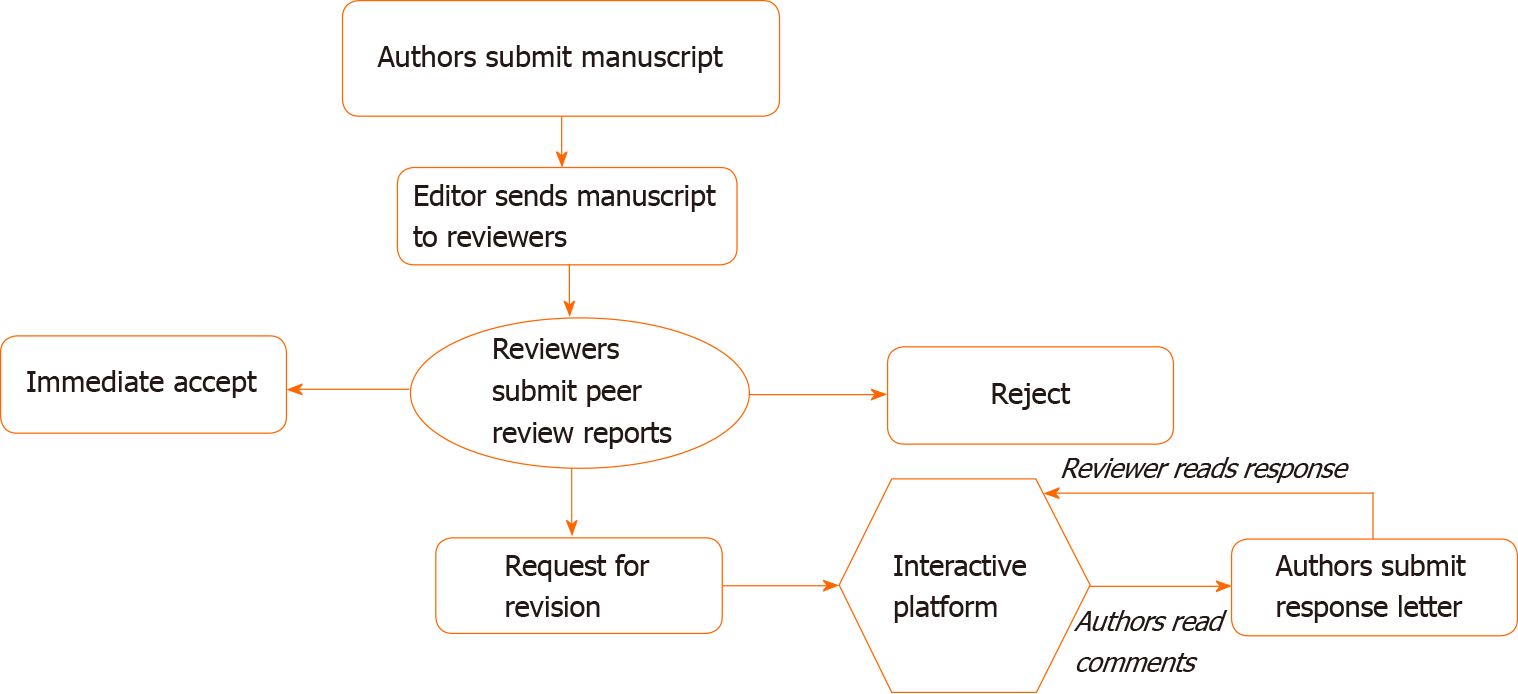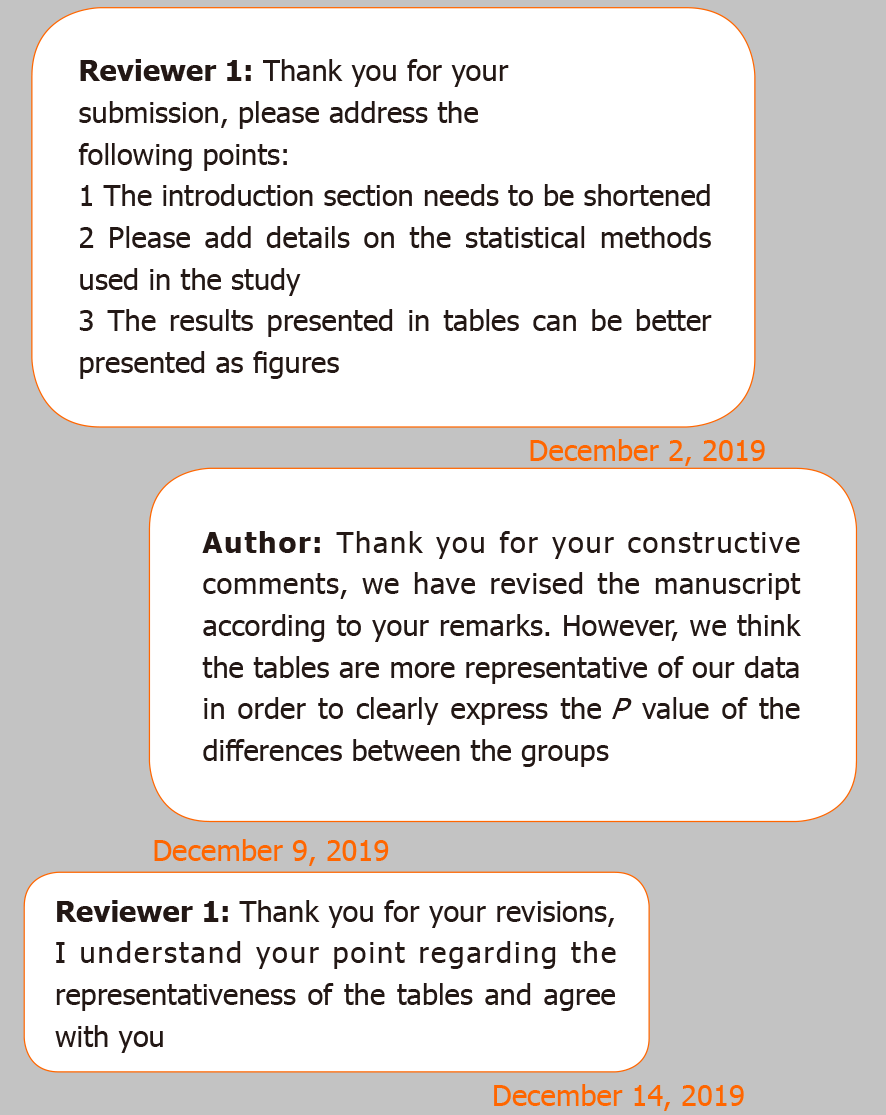Published online Feb 26, 2021. doi: 10.12998/wjcc.v9.i6.1247
Peer-review started: December 14, 2020
First decision: December 24, 2020
Revised: December 26, 2020
Accepted: January 7, 2021
Article in press: January 7, 2021
Published online: February 26, 2021
Processing time: 53 Days and 21.9 Hours
Peer review is the cornerstone in scientific publication. Although peer review has paramount importance in ensuring the quality of the published literature, it still has a number of shortcomings. The present manuscript proposes a new method to improve the current peer review system by providing an interactive, dynamic platform that allows direct, anonymous interaction between the authors of submitted manuscripts and the reviewers. Such real-time interaction may help eliminate any problems related to misunderstanding or misinterpretation of the reviewer’s comments or the authors’ response, and would save time while keeping the identity of both parties anonymous.
Core Tip: Peer review is the guarantor of the quality of the scientific literature. Although peer review plays a pivotal role in the vetting of the scholarly work submitted for publication and identification of its shortcomings and limitations, it still has its own limitations. The main drawbacks of the current peer review system are the extended time needed for reviewing articles, the difficulty in finding available expert reviewers, and the lack of direct communication between the reviewers and authors in an anonymous manner. The present editorial suggests an alternative, improved platform for peer review that involves direct communication between the authors and the reviewers in a real-time, anonymized manner. The proposed platform would provide more robust, quicker, and perhaps a fairer system for peer review of the literature.
- Citation: Emile SH. Interactive platform for peer review: A proposal to improve the current peer review system. World J Clin Cases 2021; 9(6): 1247-1250
- URL: https://www.wjgnet.com/2307-8960/full/v9/i6/1247.htm
- DOI: https://dx.doi.org/10.12998/wjcc.v9.i6.1247
Peer review is the most important guarantor of the integrity and quality of the scientific literature. Through peer review, one or more external reviewers examine the scientific merit, quality, rigor, and novelty of the presented manuscripts and usually provide constructive comments to improve the overall quality of the manuscript prior to its acceptance. Therefore, peer review is considered a quality metric that entails vetting of the manuscripts submitted for publication to identify their shortcomings and further explore their potential[1].
Common types of peer review include single-blind review in which the reviewer knows the identity of the authors but not the opposite; double-blind review in which both the authors and reviewer are anonymous to each other; and open peer review in which the identity of the authors and the reviewer is known by all participants, during or after the review process. In addition, to improve the overall process transparent peer review has been suggested. The transparent peer review system entails publishing the review reports along with the final accepted article, either with or without showing the identity of the reviewer[2].
While peer review is literally the cornerstone of scientific publication and advance, it is not without shortcomings. The major issue with peer review is that it depends entirely on the human factor, which is not free of bias and personal opinions and perspectives, at least in some cases. The dependence of peer review on the human factor has rendered the peer review process slow, inconsistent, biased, and sometimes abused[3].
Another problem with the current peer review system is the difficulty in assigning reviewers who are true experts in their field. Expert reviewers can be overwhelmed by several academic and clinical tasks and usually work under time constraints, several of whom deny the invitations to review submitted manuscripts. As such, the editor may rely on alternative reviewers who may not be sufficiently experienced in the topic of the article they are assigned, which can result in inadequate reviews. This also can lead to problems involving delayed review of manuscripts for several weeks or months, lack of providing constructive comments to improve the submitted manuscripts, and rejection of manuscripts without a proper scientific foundation. Gropp et al[4] describes the whole peer review process as a “system under stress”[4].
As we live in the era of quick and accelerated scientific advancements, perhaps the old peer review system needs to be redesigned and improved. In this editorial, we propose a modification of the traditional peer review system in which every manuscript is sent to two or more external reviewers who provide their review reports to the associate editor who then renders a decision based on these reviews and the decision is sent to the authors. During this process, the authors and the reviewer have no direct contact, and the only communication available is through the response letter prepared by the authors and sent to the reviewer. This lack of direct contact can result in some misunderstanding and misinterpretation from both parties, which may eventually lead to the rejection of meritful manuscripts.
Our proposal is to introduce an interactive, double-blind peer review system (Figure 1) in which the authors and reviewer do not know the identity of each other, yet can communicate actively and effectively in real-time. This can be established through a platform provided by the electronic submission and review system of each journal, a platform similar to common social media applications such as WhatsApp™. In this way, the reviewer writes up his/her report and uploads it to the system anonymously where the editor and the authors are able to see the reviewer’s comments in real-time. If the associate editor eventually decides to reconsider the article after addressing the reviewer’s comments, the authors would then prepare a point-by-point reply to the reviewer’s remarks and upload it to the same system. At this point, instead of just reading the authors’ reply, the reviewer and the authors can actually interact through this platform in real-time; thus, the authors can understand what the reviewer are actually asking for and the reviewer can fully comprehend the authors’ response and perspective in a clear and direct manner. An example of how the interactive peer review platform would facilitate the communication between authors and reviewers is shown in Figure 2.
The advantages of this proposed system are as follows: (1) The system is double-blind; thus, the peer review process would be impartial and would not be positively or negatively impacted by the authors’ names, affiliation, or country. (2) The real-time interaction between the authors and the reviewer would eliminate many of the problems related to the failure of interpretation of the reviewer’s remarks, hence saving time and shortening the peer review process. (3) As the authors and reviewer work together, the overall quality of the manuscript would be substantially improved with new analyses and explanations added. Even if the reviewer decides to reject the manuscript outright, they can still do so on this platform since their identity is not known to the authors.
Possible disadvantages of the proposed interactive peer review system may include: the costs associated with the establishment and maintenance of the platform and its online server, possibility of difficult access of some of the editors or the reviewers to the platform, and the fact that having a double-blind review may not enable the reviewers to identify possible conflict of interests with the authors. It is important to note that the traditional peer review system enables the editor to view the reviewers’ comments before sending them to the authors; thus, the editor can omit or edit any personal or inappropriate comments to the authors. This can be also implemented in the interactive peer review system by having the responsible editor approve the reviewers’ comments before they are posted in the platform and before the authors are able to view them.
The interactive peer review platform may facilitate direct communication between the authors and reviewers, help resolve any misinterpretations, and accelerate the process of peer review. Whether or not this proposal gets implemented in the future, we should agree that the current peer review system needs serious amendments to avoid its current drawbacks and improve the ultimate outcome of the process.
Manuscript source: Invited manuscript
Specialty type: Medicine, research and experimental
Country/Territory of origin: Egypt
Peer-review report’s scientific quality classification
Grade A (Excellent): 0
Grade B (Very good): B
Grade C (Good): 0
Grade D (Fair): 0
Grade E (Poor): 0
P-Reviewer: Trifan A S-Editor: Zhang L L-Editor: Filipodia P-Editor: Liu JH
| 1. | Gannon F. The essential role of peer review. EMBO Rep. 2001;2:743. [RCA] [PubMed] [DOI] [Full Text] [Cited by in Crossref: 23] [Cited by in RCA: 23] [Article Influence: 1.0] [Reference Citation Analysis (0)] |
| 2. | Wiley. Types of peer review. In: Wiley [Accessed in October 19, 2020]. Available from: https://authorservices.wiley.com/Reviewers/journal-reviewers/what-is-peer-review/types-of-peer-review.html. |
| 3. | Smith R. Peer review: a flawed process at the heart of science and journals. J R Soc Med. 2006;99:178-182. [RCA] [PubMed] [DOI] [Full Text] [Cited by in Crossref: 245] [Cited by in RCA: 266] [Article Influence: 14.0] [Reference Citation Analysis (0)] |
| 4. | Gropp RE, Glisson S, Gallo S, Thompson L. Peer Review: A System under Stress. BioScience. 2017;67:407-410. [RCA] [DOI] [Full Text] [Cited by in Crossref: 22] [Cited by in RCA: 22] [Article Influence: 2.8] [Reference Citation Analysis (0)] |














